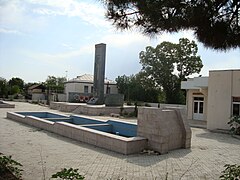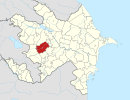
Mehmana is a village located in the Aghdara District of Azerbaijan, in the region of Nagorno-Karabakh. Until 2023 it was controlled by the breakaway Republic of Artsakh. The village had an ethnic Armenian-majority population until the exodus of the Armenian population of Nagorno-Karabakh following the 2023 Azerbaijani offensive in Nagorno-Karabakh.

Seyran Musheghi Ohanyan is an Armenian military officer and politician currently serving as a deputy in the National Assembly of Armenia. He served as Defence Minister of Armenia from 14 April 2008 until 3 October 2016. A native of Nagorno-Karabakh, he participated in both the first and second Karabakh wars, and from 2000 to 2007 served as defence minister of the unrecognized Republic of Artsakh.

Jirair Simoni Sefilian is a Lebanese-born Armenian military commander and political activist. During the First Nagorno-Karabakh War, he commanded the Shushi special military battalion, playing a significant role during the Battle of Shusha. From 1997 to 1998 Sefilian was a Brigade Commander in the Artsakh Defence Army.
Syrkhavend or Nor Ghazanchi is a village located in the Aghdara District of Azerbaijan, in the disputed region of Nagorno-Karabakh. The village had an Azerbaijani majority prior to their expulsion during the First Nagorno-Karabakh War.

Vaghuhas or Gozlu is a village located in the Aghdara District of Azerbaijan, in the region of Nagorno-Karabakh. Until 2023 it was controlled by the breakaway Republic of Artsakh. The village had an ethnic Armenian-majority population until the exodus of the Armenian population of Nagorno-Karabakh following the 2023 Azerbaijani offensive in Nagorno-Karabakh.

Verin Horatagh or Yukhary Oratagh is a village in the Aghdara District of Azerbaijan, in the region of Nagorno-Karabakh. Until 2023 it was controlled by the breakaway Republic of Artsakh. The village had an ethnic Armenian-majority population until the exodus of the Armenian population of Nagorno-Karabakh following the 2023 Azerbaijani offensive in Nagorno-Karabakh.
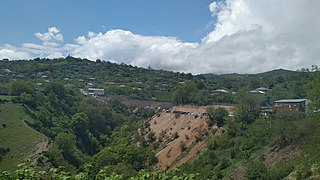
Haterk or Hasanriz is a village in the Aghdara District of Azerbaijan, in the region of Nagorno-Karabakh. Until 2023 it was controlled by the breakaway Republic of Artsakh. The village had an ethnic Armenian-majority population until the exodus of the Armenian population of Nagorno-Karabakh following the 2023 Azerbaijani offensive in Nagorno-Karabakh.
Vardadzor or Gulyatag is a village that is located in the Aghdara District of Azerbaijan, in the region of Nagorno-Karabakh. Until 2023 it was controlled by the breakaway Republic of Artsakh. The village had an ethnic Armenian-majority population until the exodus of the Armenian population of Nagorno-Karabakh following the 2023 Azerbaijani offensive in Nagorno-Karabakh.

Kusapat or Chiragly is a village in the Aghdara District of Azerbaijan, in the region of Nagorno-Karabakh. Until 2023 it was controlled by the breakaway Republic of Artsakh. The village had an ethnic Armenian-majority population until the exodus of the Armenian population of Nagorno-Karabakh following the 2023 Azerbaijani offensive in Nagorno-Karabakh.
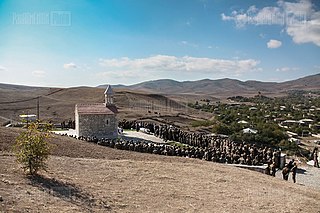
Nerkin Horatagh or Ortakend is a village in the Aghdara District of Azerbaijan, in the region of Nagorno-Karabakh. Until 2023 it was controlled by the breakaway Republic of Artsakh. The village had an ethnic Armenian-majority population until the exodus of the Armenian population of Nagorno-Karabakh following the 2023 Azerbaijani offensive in Nagorno-Karabakh. The village is located close to the town of Martakert.
Varnkatagh or Lulasaz is a village located in the Aghdara District of Azerbaijan, in the region of Nagorno-Karabakh. Until 2023 it was controlled by the breakaway Republic of Artsakh. The village had an ethnic Armenian-majority population until the exodus of the Armenian population of Nagorno-Karabakh following the 2023 Azerbaijani offensive in Nagorno-Karabakh.

Madagiz or Sugovushan, is a village in the Aghdara District of Azerbaijan. The village had an ethnic Armenian-majority population prior to the 2020 Nagorno-Karabakh war. Madagiz was part of the Martakert Province of the breakaway Republic of Artsakh between 10 April 1994 and 3 October 2020.
Chayly or Aygestan is a village in the Aghdara District of Azerbaijan, in the disputed region of Nagorno-Karabakh. Prior to 2023, the village was on the ceasefire line between the armed forces of the breakaway state Republic of Artsakh and those of Azerbaijan.

Talish is a village in the Aghdara District in Azerbaijan, in the disputed region of Nagorno-Karabakh. The village had an ethnic Armenian-majority population prior to the 2020 Nagorno-Karabakh war, and also had an Armenian majority in 1989.
Chapar is a village located in the Aghdara District of Azerbaijan, in the disputed region of Nagorno-Karabakh. Until 2023 it was controlled by the breakaway Republic of Artsakh. The village had an ethnic Armenian-majority population until the exodus of the Armenian population of Nagorno-Karabakh following the 2023 Azerbaijani offensive in Nagorno-Karabakh.

Jraberd or Chileburt is a village located in the Aghdara District of Azerbaijan, in the region of Nagorno-Karabakh. Until 2023 it was controlled by the breakaway Republic of Artsakh. The village had an ethnic Armenian-majority population until the exodus of the Armenian population of Nagorno-Karabakh following the 2023 Azerbaijani offensive in Nagorno-Karabakh.

Mardakert District was an administrative unit within the former Nagorno-Karabakh Autonomous Oblast (NKAO) of the Azerbaijan Soviet Socialist Republic.

Onik Viktori Gasparyan is an Armenian Colonel-General who served as the Chief of the General Staff of the Armenian Armed Forces from 8 June 2020 until his dismissal on 10 March 2021. Gasparyan was dismissed after calling for the resignation of Prime Minister Nikol Pashinyan on 25 February 2021 along with more than 40 other high-ranking Armenian military officers.
Tiran Vazgeni Khachatryan is an Armenian lieutenant general who formerly served as the First Deputy Chief of the General Staff of the Armed Forces of Armenia. During the 2020 Nagorno-Karabakh war, Khachatryan was conferred with the title of National Hero of Armenia.
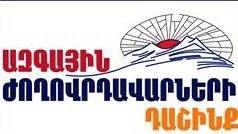
The National Democrats Union, also known as the Alliance of National Democrats is an Armenian political party.










